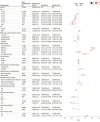Hospital Readmissions Among People With Sickle Cell Disease
- PMID: 40526379
- PMCID: PMC12175023
- DOI: 10.1001/jamanetworkopen.2025.17974
Hospital Readmissions Among People With Sickle Cell Disease
Abstract
Importance: While advances in the management and treatment of sickle cell disease (SCD), the most common inherited disorder in the United States, have improved outcomes, hospital readmissions remain a significant concern. Thirty-day hospital readmissions is a key quality-of-care indicator; however, there are limited contemporary nationally representative data on SCD readmissions.
Objective: To characterize national trends in SCD-related readmissions in the United States and describe factors associated with readmission among patients with SCD.
Design, setting, and participants: This cohort study included patients with SCD aged 18 years and older. Patients were identified in the Nationwide Readmissions Database (NRD), an all-payer database of US hospitalizations, using International Statistical Classification of Diseases, Tenth Revision, Clinical Modification (ICD-10-CM) codes. Data were collected from January 2016 to December 2021 and analyzed from May to September 2024.
Main outcomes and measures: Readmission was defined as subsequent admission within 30 days of hospitalization discharge using the Centers for Medicare & Medicaid Services methodology. The 30-day all-cause unplanned readmission risk among adults with SCD was estimated, and the trend in 30-day readmissions among adults with and without SCD was assessed by calendar year from 2016 to 2021. Survey-weighted mixed-effect Poisson regressions were used to identify factors associated with readmission.
Results: From 2016 to 2021, 140 096 807 all-cause index hospitalizations and 592 951 SCD-related index hospitalizations were analyzed. Patients with SCD had a stable readmission risk of approximately 34% (annual range, 32.6%-34.3%), significantly higher per year than the approximately 12% readmission risk among patients without SCD (annual range, 12.0%-12.2%) (P < .001). In 2021, there were 92 536 index admissions from 37 410 unique patients with SCD (median [IQR] age, 34 [26-46] years; 22 484 [60.1%] female), with 30 467 readmissions. Younger patients (aged 18-29 years) had the highest readmission risk at 35.1%. In multivariable model among patients with SCD, patients from the highest-income zip codes had lower readmission risk than those from lower-income areas (adjusted risk ratio [aRR], 0.90; 95% CI, 0.84-0.97). Admissions paid by Medicare and Medicaid were associated with higher readmission risk than private insurance (Medicare: aRR, 1.67; 95% CI, 1.56-1.78; Medicaid: aRR,1.53; 95% CI, 1.43-1.63). Vaso-occlusive crises at index admission were associated with higher readmission risk (aRR, 1.31; 95% CI, 1.25-1.37). Fewer readmissions were observed in patients receiving simple (aRR, 0.86; 95% CI, 0.82-0.91) and exchange (aRR, 0.78; 95% CI, 0.61-0.99) red blood cell transfusions.
Conclusions and relevance: In this cohort study with nationally representative data, patients with SCD had a significantly higher readmission risk than patients without SCD. Preventative, disease-modifying, and curative interventions are needed to reduce readmission risks and improve outcomes for patients with SCD.
Conflict of interest statement
Figures



References
Publication types
MeSH terms
Grants and funding
LinkOut - more resources
Full Text Sources
Medical

